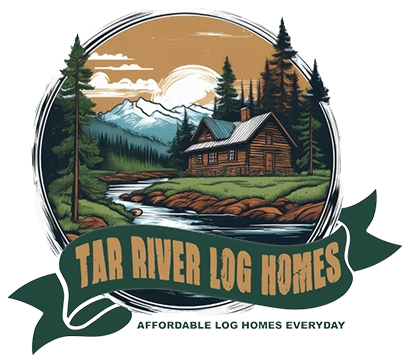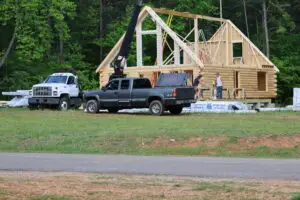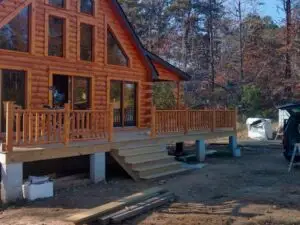Thinking about building your own log home? Then you’ve probably wondered what comes in a log kit.
A kit is designed to give you the essentials—pre-cut logs, hardware, and blueprints—so you can get your project moving without confusion. Knowing exactly what’s inside helps you plan ahead and avoid unexpected costs.
At Tar River Log Homes, we keep things simple: kiln-dried eastern white pine logs, clear instructions, and wholesale pricing. No fillers, no hidden extras. Whether you’re tackling a full-size home or a cozy cabin, understanding what’s included in your kit is the first step to building with confidence.
In this guide, we’ll walk through what you’ll find in a log kit, what’s not included, and how to make the most of it.
Log Kit Contents Overview
A log kit’s got what you need to kick off your log home. It comes packed with essential materials, hardware, and info to help you get started. It’s worth knowing how these parts work together and which homes they suit best.
Core Components
A standard log kit gives you logs, fasteners, and construction materials. The logs are pre-cut and kiln-dried—think main wall logs, gable logs, and floor or ceiling logs, all in the sizes you’ll need.
You’ll also find metal fasteners (spikes, screws), sealant to keep out the weather, and blueprints with step-by-step instructions. Some kits throw in windows and doors, though not always.
Foundation & Roofing: What’s Usually Not Included
Most log kits include pre-cut wood and instructions, but don’t include foundations or roofing systems. You’ll need to plan and purchase those separately—think trusses, shingles, underlayment, and a reinforced foundation to support the log walls.
Understanding what’s excluded helps prevent surprises and keeps your budget on track.
Purpose and Application
The kit’s meant to simplify building. Pre-cut materials mean less guesswork and fewer supply runs. The instructions walk you through the structure, from the ground up.
You can use these kits for a full log house or a cozy cabin. They’re a good fit whether you’re going DIY or hiring some help. Kits cover walls, floors, and roof framing, but you’ll need to handle plumbing and wiring separately.
Compatibility Considerations
Log kits match up with specific home designs and sizes. Make sure the kit fits your plans. Some are for small cabins, others for big homes.
The logs need to work with your foundation and roof setup. Not every log type suits every plan, especially if you’ve got something unusual or custom in mind. You can choose from different options to fit your style and budget, making the whole process smoother.
Hardware Included in a Log Kit
When you order a log kit, you get essential hardware to put everything together. That means stuff for tracking construction, sensors for conditions, mounting pieces, plus all the cables and connectors you’ll need. Every part matters for a solid, long-lasting build.
Logging Devices
Logging devices help you track progress and keep tabs on conditions during the build. Usually, you’ll get handheld data loggers or digital readers to measure humidity and temperature, key for drying logs right and avoiding cracks.
Some kits include log scanners to check the quality of each log before you install it. These gadgets are battery-powered, made for the outdoors, and have simple displays so you’re not squinting at tiny screens.
Sensors
Sensors keep an eye on your build environment. Humidity sensors watch for moisture inside and outside your logs to prevent rot. Temperature sensors track weather swings so you know when to cover up the logs.
A few kits add pest sensors to catch bugs early. These often plug right into your logging devices or a small control unit. Keeping tabs on these things helps you dodge expensive repairs later.
Mounting Accessories
Mounting accessories—brackets, screws, metal plates—secure your logs and hardware as you build. Pre-cut holes and fittings make assembly quicker and joints more solid.
Good mounts keep everything lined up and steady, even when the wind picks up or the house settles. They’re usually rust-resistant steel, built to last outside for years.
Cables and Connectors
Cables and connectors tie together the electronic parts of your log kit. You’ll get power cables for loggers, sensor wires, and connectors for easy setup. They’re made to handle the weather since most of this stuff lives outdoors for a while.
Extension cables help reach tricky spots, and connectors are designed to fit the sensors without much hassle. These keep your monitoring setup running smoothly.
Software and Digital Resources
Order a log home kit, and you’re not just getting wood and nails. You also get digital tools and guides to help plan, build, and manage your project. These make things clearer and, honestly, less stressful.
Configuration Tools
Configuration tools let you customize your log home before you start. You’ll usually get access to simple software or web apps where you can tweak room sizes, wall layouts, and roof styles. You get to see how your choices play out in real time.
No guessing about the final look. You can mess around with options and change things up without extra cost. These programs are easy enough that you don’t need to be tech-savvy.
Data Analysis Programs
Data analysis programs help you figure out material needs, costs, and energy use. They give you charts and tables so you know what to expect for your budget and schedule.
You can track exactly what you need, which helps avoid waste or missing parts. That keeps your project on budget and moving forward.
User Manuals and Guides
You’ll get detailed manuals that lay out how to assemble each part. The instructions are step-by-step and written in plain language.
They cover everything from stacking logs to sealing gaps, plus safety tips and tool advice. Tar River Log Homes makes sure you’re set up to succeed—no guesswork.
Power and Connectivity Options
Your log kit comes with options to keep your tools and devices powered, whether you’re on the grid or out in the woods. You get to pick what works best for your project.
Power Supplies
Most log kits offer power supply options that connect to your home’s electrical system. That means standard outlets and wiring pieces that match your log home’s setup.
The power supplies are easy to install and include circuit breakers, plugs, and switches to keep your electrical system safe.
Rechargeable Batteries
Rechargeable batteries are handy if you’re building somewhere remote. They’ll power smaller tools, lights, or gadgets without needing an outlet. These battery packs last through long workdays and recharge with simple adapters.
You can swap them out fast if you need to, so you don’t lose momentum. The kit includes reliable power options—whether you want plug-in power or the freedom of rechargeable batteries, it’s ready for either.
Maintenance and Spare Parts
Keeping your log home in good shape means having the right parts and cleaning supplies nearby. You want to be able to swap out worn pieces and keep things clean so the wood lasts.
Replacement Components
Your kit includes replacement parts for common repairs, like:
- Extra chinking strips for sealing up gaps
- Replacement dowels or fasteners for securing logs
- Trim and corner notches for edges that take a beating
- Sealants or caulking to keep water out
Having these ready means you can fix things fast, without waiting for shipments.
Cleaning Supplies
Log homes need gentle care. Your kit comes with cleaning products made just for logs, so you can get rid of dirt, mildew, and stains without damaging the wood.
You’ll find:
- Wood-safe cleaners for inside and out
- Brushes and scrubbers with soft bristles
- Protective finishes to keep moisture at bay
A little regular cleaning keeps your home looking sharp and the logs in good shape.
Additional Features and Upgrades
You’ve got choices to make your log home kit even better. These extras give you more freedom, storage, or style—whatever you’re after.
Wireless Modules
Wireless modules let you connect devices without running wires everywhere. Add sensors for temperature, humidity, or security, and control them from your phone or tablet over Wi-Fi or Bluetooth.
They save setup time and keep things tidy. If you want smart home features later, these modules make upgrades easier.
Data Storage Expansion
Some kits come with controls or software for managing your home. More data storage means you can keep extra records—energy use, temperature logs, maintenance notes.
It’s helpful if you want a detailed history or plan to connect lots of devices. You won’t run out of space, and your info’s all in one spot.
Customization Options
You can pick upgrades for how your log home looks or works. That might mean different window or door styles, roofing materials, special wood finishes, or extra insulation.
Customizing lets you match your home to your taste and local weather. You can add upgrades to get what you want, without blowing the budget.
Safety and Support Materials
Order a kit and you’ll get packaging and support materials to protect your logs and help if things go sideways. That means solid cases, warranty paperwork, and contact info for help.
Protective Cases
Logs and parts come packed in sturdy cases that keep everything safe and dry during shipping. The bundles are wrapped tightly to stop shifting and scratches.
These cases are sized for trucks and forklifts, so unloading is safer. They shield your wood from weather and rough handling.
Warranty Information
You get warranty papers that spell out what’s covered—usually cracks or warping that shouldn’t happen. The paperwork explains how long coverage lasts and what to do if you need to make a claim. Keep it handy, just in case.
Technical Support Details
You’ll also get contact info for technical support. If you hit a snag or need advice, you can call or email real people who know log homes inside and out.
Support covers assembly, tool questions, and helps with materials. The team aims to give you clear answers and keep your build on track.
Why a Log Kit Makes Building Easier
A log kit gives you the essentials to start your project with confidence. From pre-cut logs to hardware and blueprints, you get a clear path forward without guesswork.
Of course, you’ll still need to handle things like roofing, plumbing, and finishes. But the kit takes care of the heavy lifting—simplifying the hardest part of building a log home.
At Tar River Log Homes, we focus on supplying high-quality eastern white pine kits at wholesale prices. That way, families can build strong, affordable homes without dealing with hidden costs.
Ready to start your log home project? Reach out and see how affordable building can be.
Frequently Asked Questions
Building with a log kit is all about picking the right items and options for your needs and budget. Figuring out what’s in each package, how you can pay, and what everything really costs makes planning a whole lot easier—or at least, less confusing.
What items are typically found in a basic log cabin kit?
A basic kit usually comes with pre-cut logs for the walls, floor, and roof systems, doors, windows, and all the fasteners you’ll need. You’ll get blueprints that actually make sense (most of the time). These kits often use kiln-dried Eastern White Pine logs, so you’re not waiting around for wood to dry out.
Can you explain the financing options available for log cabin kits?
Most companies work with third-party lenders or let you use a personal loan. Most suppliers walk you through payment schedules, but it’s smart to check your own credit options first. Paying as you go—stage by stage—seems to be the norm.
How does the cost of DIY log home kits compare to professional builds?
DIY kits are way cheaper since you’re not paying for someone else’s labor. Tar River Log Homes sells materials at wholesale prices, which definitely helps. If you hire pros, installation costs can pile up fast. Of course, you’ll need to factor in your own time and skill level—nobody said it’d be easy, but you might save a bundle.
What is usually included in a full log home package deal?
Full packages tend to cover everything from the logs to the roofing materials, sometimes even interior bits like cabinetry or plumbing rough-ins. Some deals toss in insulation and hardware, but you’ll probably pay extra for electrical work. Always double-check what’s actually in the box—surprises aren’t always fun.
What should someone expect in a small log cabin kit?
Small kits keep things simple—fewer logs, straightforward plans, and just the basics. You’ll get framing, doors, and windows, usually for cabins under 1,000 square feet. Fewer extras mean a lower price and a faster build, which is pretty ideal if you’re new to this or just want a cozy weekend spot.
Are there any customizable options in standard log cabin homes?
Absolutely, you’ve got choices—log styles, window sizes, and floor plans can all be tweaked to fit what you want. Tar River Log Homes gives you style flexibility, so you can really pick what feels right for you. Sure, adding custom features might bump up the price a bit, but honestly, isn’t it worth it to have a cabin that’s truly your own?





